GPU Absurdity: AMD RX 9070 XT Waifu vs. Red Devil Ultimate Showdown

The Yeston RX 9070 XT Sakura Sugar Atlantis OC Edition weighs in at $900 and has its own YouTube channel devoted to Sakura, the angel of the ocean, including power move footage of soaking a video card in the very ocean sands whence it came.

And when Yeston finally releases its much anticipated Husbando video card, named after the cool and aloof character “GAME ACE,” it’s GAME OVER for PowerColor’s Red Devil.
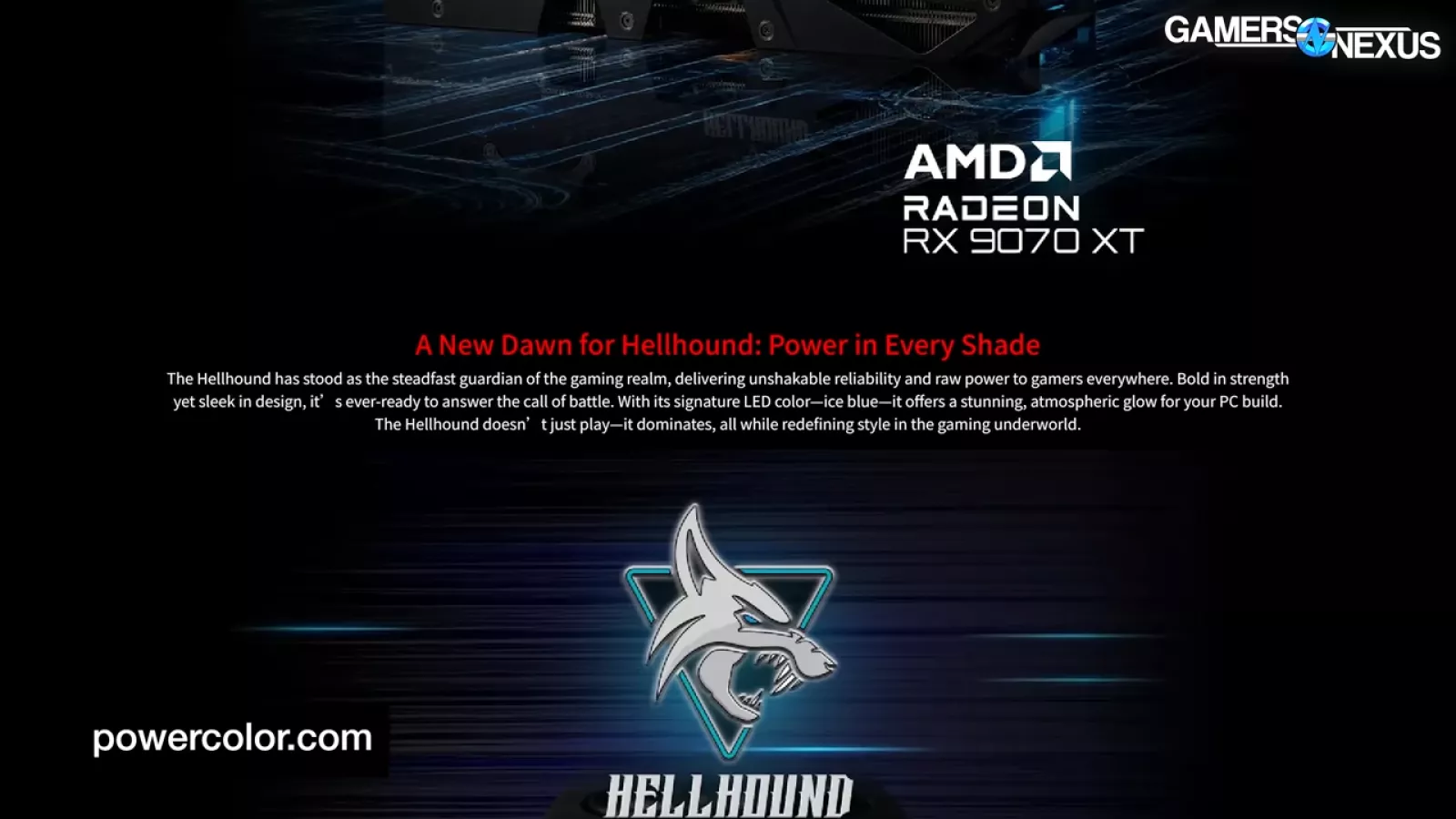
But Yeston isn’t alone in this battle of gamer marketing: PowerColor’s Hellhound says it has a “New Dawn” and “Power in Every Shade,” And… we don’t know what that means.
But it sounds scary — almost as scary as the RED DEVIL, the natural counter to the WAIFU. The Red Devil says its Hellstone is “born from darkness, radiating power,” “forged in the fires of the underworld and inspired by the cradle of the rarest gems.” PowerColor “emerges as the unparalleled force in gaming, pushing performance to its absolute peak,” and “at its core lies the Hellstone, a breathtaking design element where vibrant RGB pulses with an otherworldly glow, embodying fiery power and precision.”
Such a stone sounds too powerful to be in the hands of mere, filthy casuals. The breathtaking design element Hellstone is made of hundred-million-year-old materials dug from the depths of the earth. We’re told that it’s made of a rare, nearly unattainable polymeric matrix composite from hydrocarbon polymers, known only to mortal humans as… “plastic.”
This is the battle you all have been waiting for. It is the ultimate GPU sh*tpost — second only to the one that NVIDIA just made by launching the so-called RTX 5050 (watch our coverage).
And if you’re wondering if this is just one gigantic meme with actual testing that required dozens of hours of work and hundreds of thousands of dollars worth of equipment all for this one meme, then yes. Yes it is. But it does have an important conclusion. And we are going to get to the bottom of who is better between the RED DEVIL VS. the WAIFU. Let’s battle.
Testing
Despite the jokes, we do actually have testing in our review. We’re testing thermals, some power, acoustics, frequency, and a couple of games.
The main reason we’re looking at games is because the 9070 XT Red Devil is running at a pretty high clock compared to other 9070 XTs so we wanted to look at that to see how much it actually mattered.
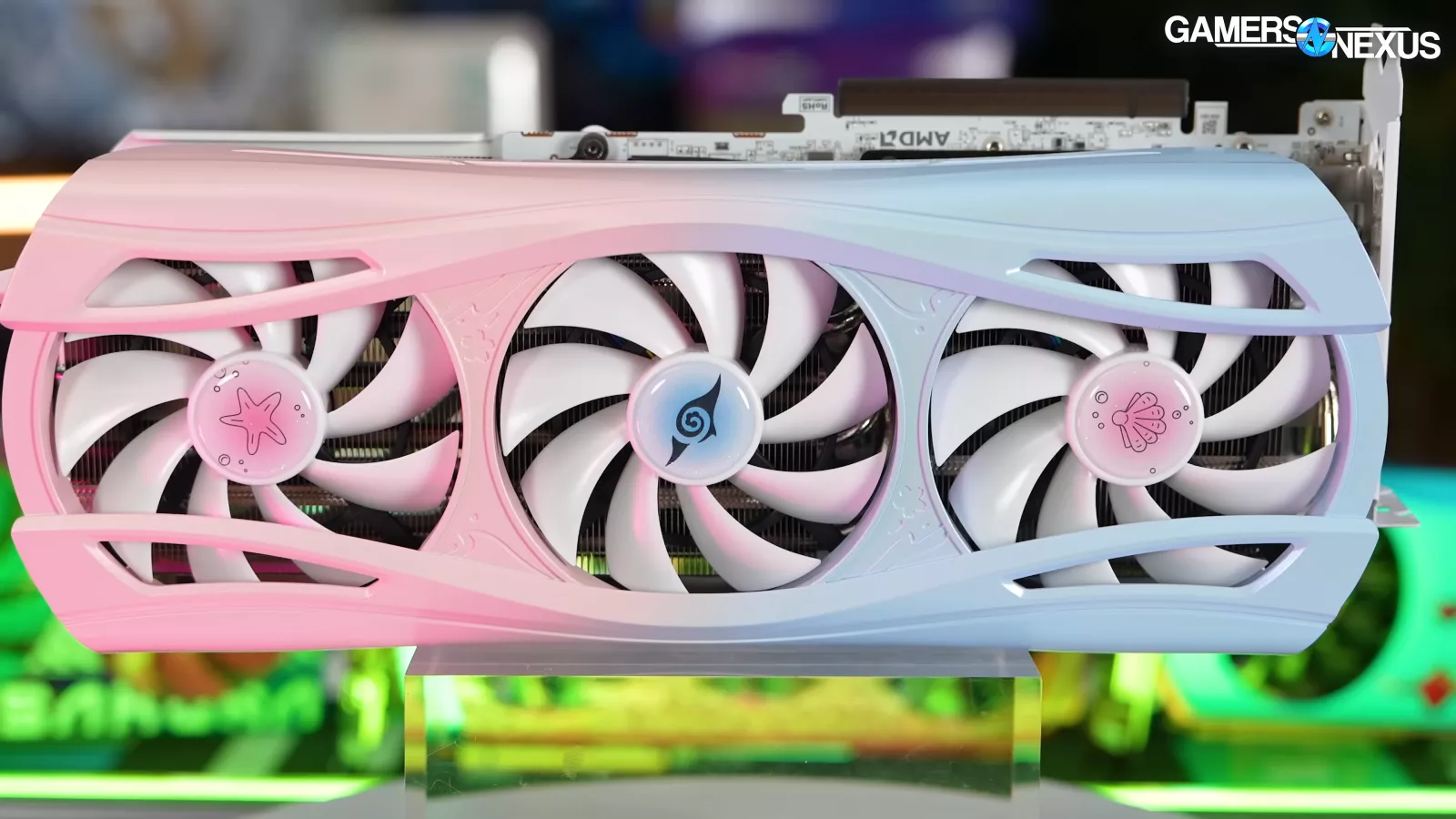
The biggest issue with both cards is that they are currently $900, which is completely insane because MSRP is allegedly $600 for the 9070 XT, though that’s not really the case. Regardless, $900 is still pretty high.
Both the cards we’re reviewing here have dual vBIOS and share a lot of common features. This means we’re going to focus most on aspects that are likely to be different. This includes thermals and acoustics.
Thermals
The first test of prowess for these embattled icons is one of thermals: The Hellstone has a clear disadvantage here, mostly because it’s, uh, from hell, and the Waifu has an advantage with its affinity for oceans and Atlantis.
For this testing, our methodology involved testing the auto out-of-box settings in addition to testing with noise-normalized manual overrides to ensure an even battlefield. Waifus and Devils make different noises at different volumes, after all, and so it’s only fair to normalize them.
The normalization required use of our hemi-anechoic chamber that we had custom-built exactly for purchases like this. You might think that spending $250,000 on a chamber to test the audio quality of meme video cards is insane, and you’d be right. That’s why we also test non-memes in it and use it every single benchmarking and technical reviews that we do for coolers and cases. To support our ability to buy test equipment like this and provide accurate data, head over to store.gamersnexus.net and grab one of our unique 3D Coaster Packs, like from our Debug pack. These have carefully placed and tested components to stabilize drinkware while providing a soft, rubberized material with PC theming. The debug code and power and reset switches on the red-and-black motherboard is one of our favorites, although the original coaster pack (also on the store) has the fan coaster that works surprisingly well and is also the most popular. Each pack comes with 4 coasters. Despite price increases over the years, we have maintained our original price. Head over to store.gamersnexus.net to grab these and support our in-depth testing and reviews — even for memes.
Let’s get into the tests.
Thermals – 3DM 4K Auto VBIOS
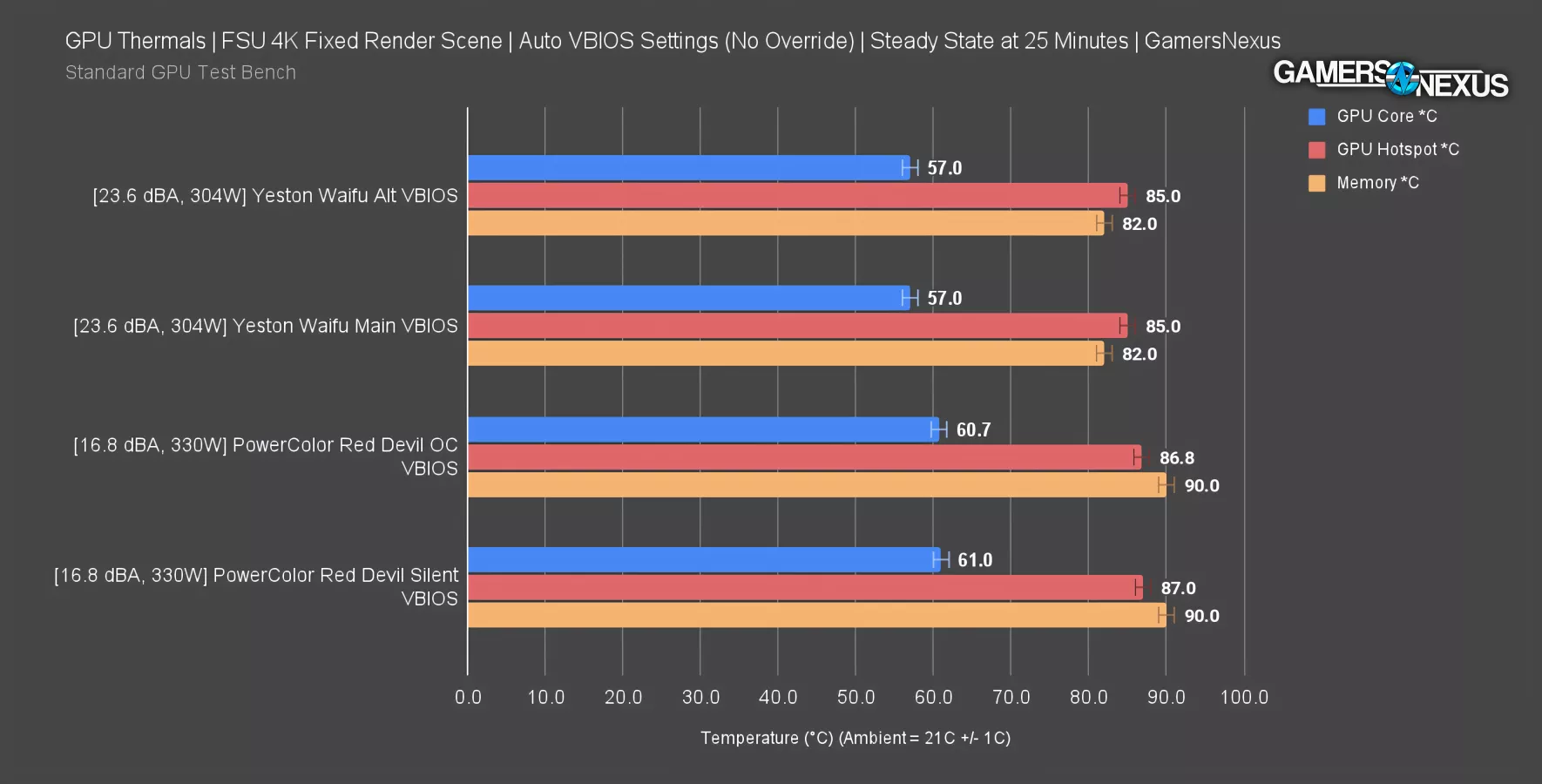
The Waifu starts out with a strong showing when set to follow the default VBIOS profile and temperature targets with auto fan controls. The Atlantis-dweller ran at 57 degrees Celsius at steady state in a controlled ambient setting for GPU core on both the main and alternate VBIOS; in fact, as we showed in our Yeston Waifu review, the VBIOSes appear to do the same thing. It’s like they didn’t reprogram one of the fan curves or something, which may be a mistake.
But these temperatures are completely acceptable. They are maintained at 23.6 dBA and about 304W via GPU-Z board power monitoring.
The PowerColor Red Devil runs hotter: Its default OC VBIOS held a 60.7-degree result, with the silent VBIOS also seemingly the same. This has happened for multiple generations now with both Yeston and PowerColor. Maybe because the load hits steady state, they end up settling in the same place once under sustained load. We are restarting between each VBIOS change and even inspect the VBIOS profile name when switching to confirm that it does toggle. This process works to show differences in other devices, but at least here, we’re seeing the same across the profiles. That at least keeps it simple.
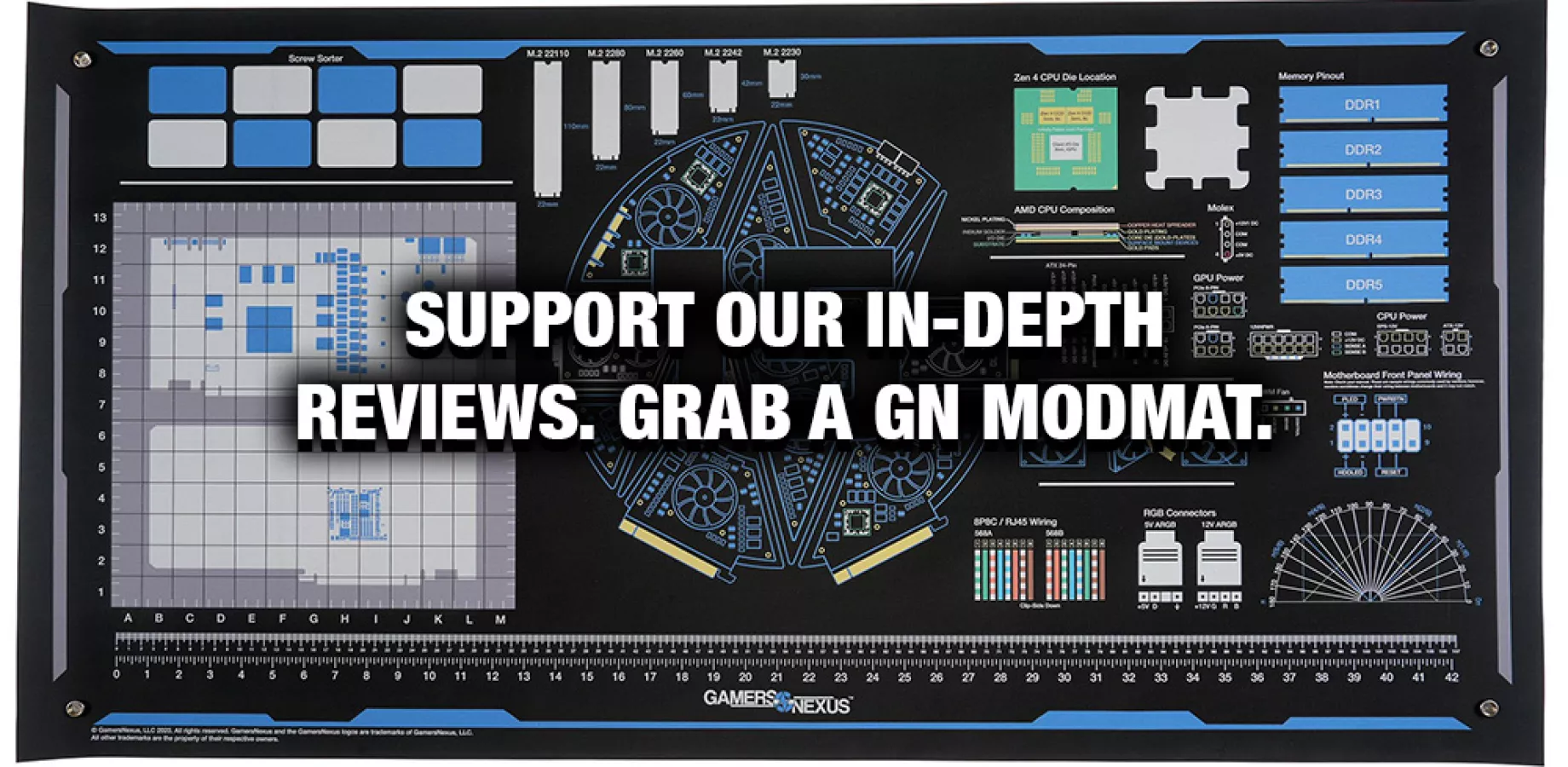
The Red Devil is running about 3-4 degrees warmer on the GPU and about 1-2 degrees warmer on the hotspot, with memory at a substantial climb of 8 degrees warmer. There’s a deficiency in memory cooling on the Red Devil by comparison, but an advantage in the hotspot-to-core delta, where Yeston’s delta is greater.
But there’s one other important factor: Out of the box, the PowerColor card is pulling 30W more via GPU-Z logging. This puts them at more equal thermal footing when considering the increased power consumption. The fan speed is another huge factor. So that was out of the box thermal performance, but we can start controlling these variables.
Thermals – 3DM 25 dBA
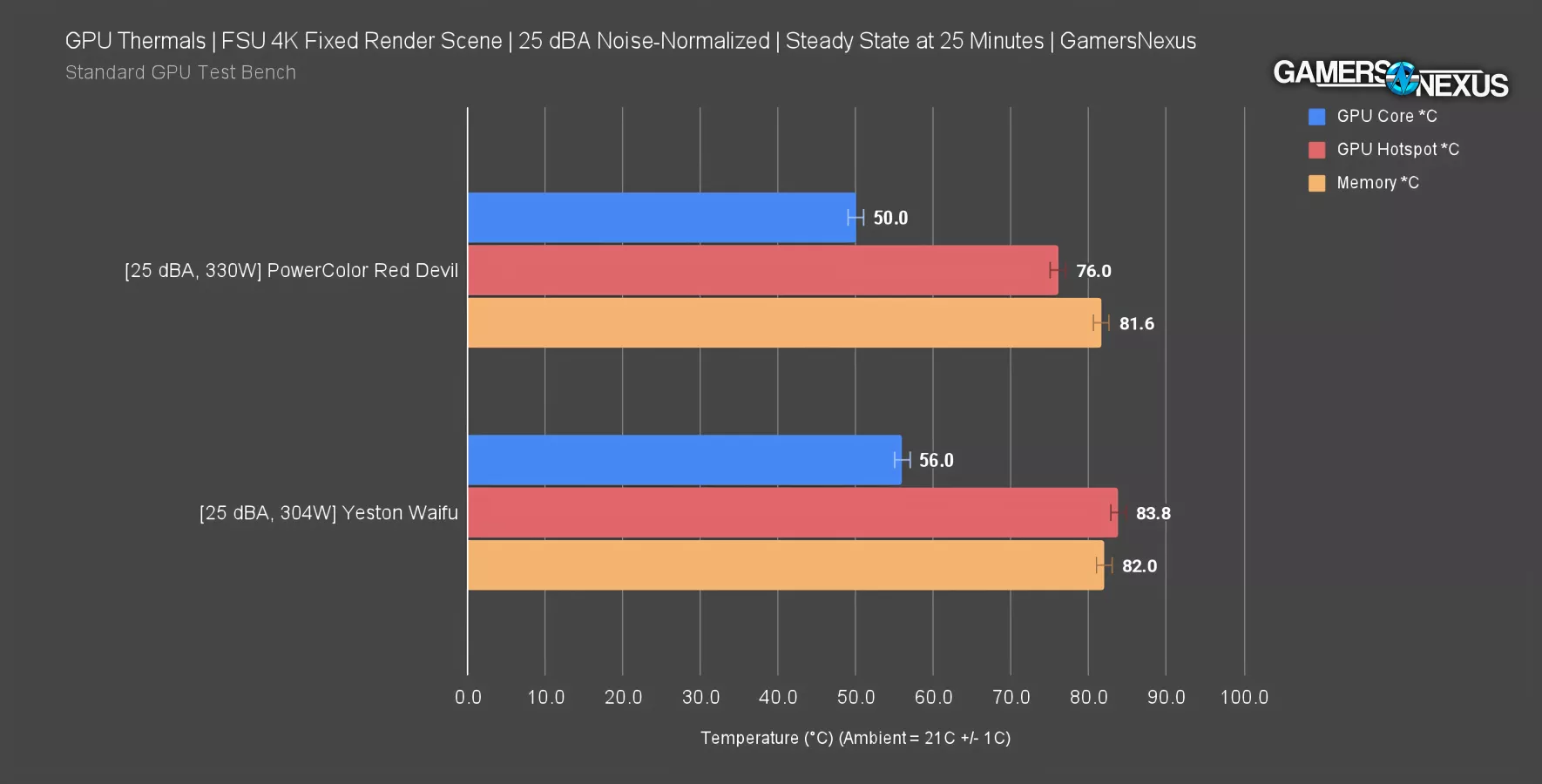
This test normalizes the GPUs for noise levels. We ran both at 25 dBA at 1-meter for this test.
The steady state 3DMark workload has the Waifu now 6 degrees warmer than the Red Devil in a searing blow to the Waifu, whose ocean and its scent-imbued plastic is evaporating before our very eyes. Boosting the Red Devil’s fan speeds to match the noise levels of the Waifu’s brings it down significantly, showing that it is the better card in like-for-like acoustic testing. Even with its smoldering Hellstone, the Red Devil has a 76-degree hotspot and delta of 26 degrees, improved from the Waifu’s 84-degree hotspot delta of 27.8-degree delta. This means the waifu is hotter here. Memory thermals are functionally tied between them, showing that PowerColor’s main area to improve is VRAM thermals. All of these numbers are acceptable, though, with the GPU numbers just straight-up good for both companies.
Notably, PowerColor is achieving these results with higher power draw. It lost when auto due to poor fan configuration, but pulls ahead when manually normalized.
Thermals – FurMark 25 dBA
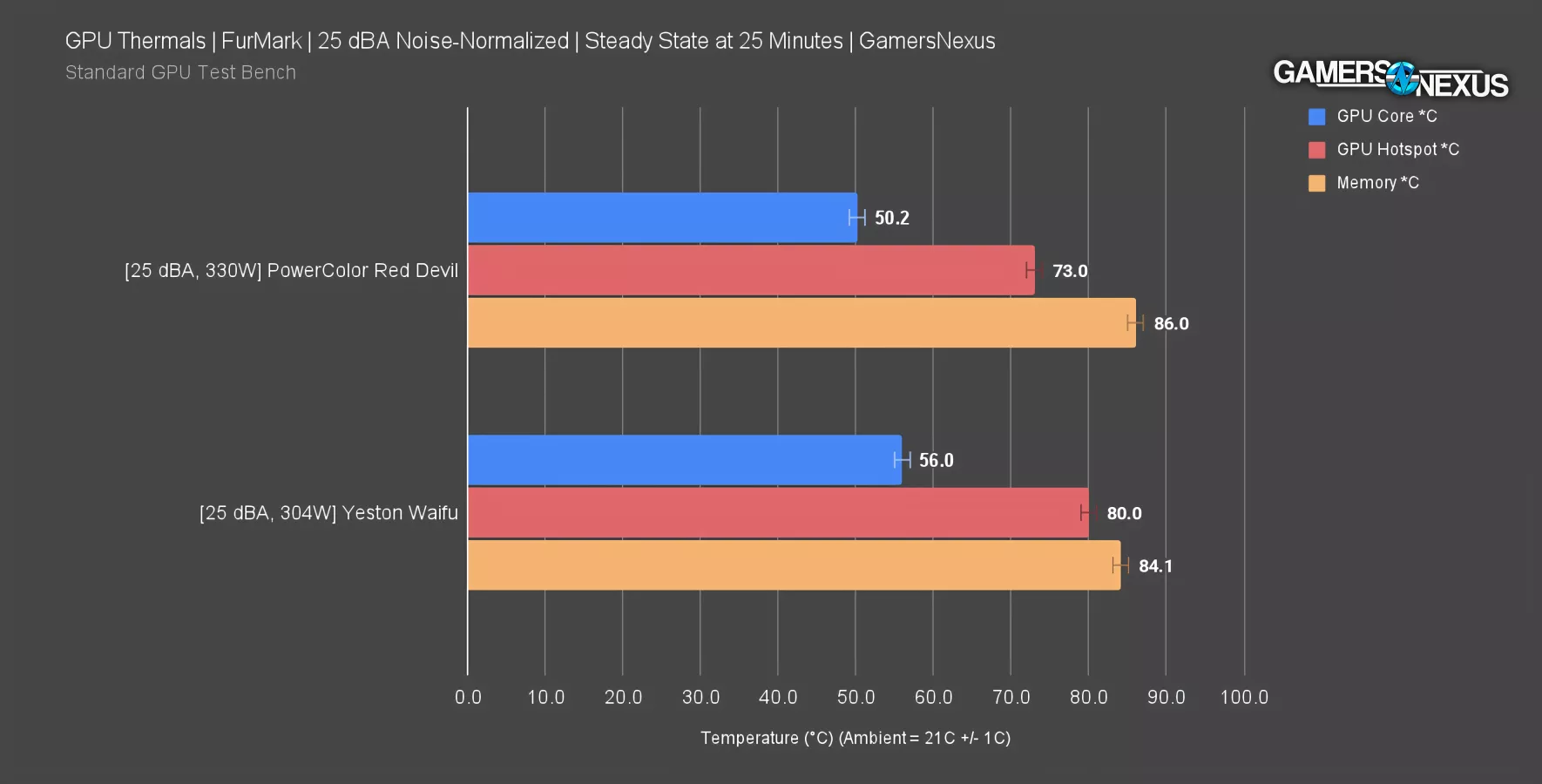
In FurMark at 25 dBA, which loads the GPUs more heavily on the VRM, the GPU temperatures ended up comparable between these with the memory temperatures favoring the Waifu by about 2 degrees reduced from the Red Devil.
Acoustics
But this doesn’t mean much without acoustics.
The most natural and first test of a Devil against a Waifu is the noise that they make in battle. For this reason, we threw these two GPUs into our battle arena: The hemi-anechoic chamber.
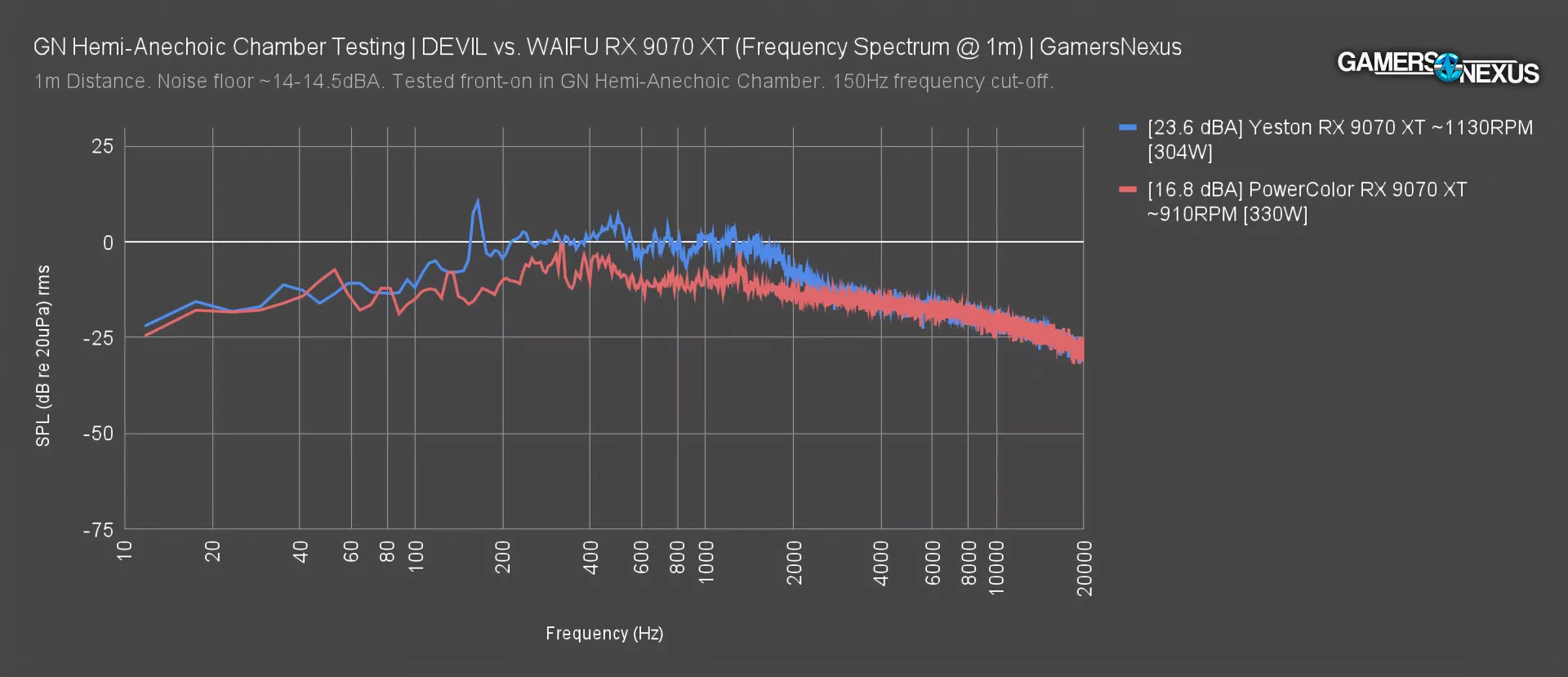
The Yeston RX 9070 XT Waifu edition ran at 1,130 RPM when under default VBIOS control at 304W in the workload that we ran. The card ran at 23.6 dBA at 1 meter when tested under the conditions we used for thermal testing. The frequency spectrum analysis has the highest spike around 164 Hz, with a swell around 500 Hz and a later bump and dip in the range of 1,000 Hz to 1,400 Hz.
The PowerColor Red Devil ran at 16.8 dBA, which is really quiet for what we would imagine of hell. It’s too close to our floor to be all that useful. The Devil is substantially quieter out of box, mostly because it just isn’t utilizing its fans as well as we think it should be — that’s why it ran warmer in the auto testing. We did some in-depth investigating and realized it’s because the Hellstone converts the Red Devil’s angry howlings into the power needed to sustain its own power consumption, destroying the sound waves in the process. Fans ran at 910 RPM rather than 1,130 RPM, which means it’s quiet, but we think also not properly utilized. PowerColor could find more of a balance here, although maybe they’re trying to remain true to the fiery marketing.
The frequency spectrum has the Devil’s peak at around 320 Hz, with an elevated area around 420 Hz. Overall, it’s a lot quieter than the Waifu, with the high-end of the frequency scale similar.
Acoustics – Noise-Normalized

When normalized to roughly the same noise levels, leaving the Yeston card on the chart, the Red Devil’s new frequency spectrum has the Devil’s peak at about 200 Hz. There’s a slight wave up around 400-500 Hz and another around the same place as the Yeston card, at 900 Hz, then a dip, then up again at around 1,200 Hz.
Frequency

GPU frequency is the next test in this battle of the memes. The Yeston GPU ran at about 2,890-2,910 MHz in this workload when running a fixed frame render. The Red Devil ran notably higher, up at 2,970-3,000 MHz instead. That’s around a 60-100 MHz bump in most instances, so the extra power is going somewhere, and it’s sustaining that frequency.
Plotting the Sapphire Pulse as a frame of reference, it holds about 2,900-2,925 MHz at steady state, putting it slightly faster than the Yeston card. The Waifu’s desired frequency just happens to be lower than that of the Pulse and Red Devil.
Gaming Performance
We’ll do a quick look at gaming performance to see how much that extra frequency does or doesn’t matter. This will be a very slimmed-down version of our tests since we only need a few head-to-head results. These were tested on the same drivers, so for purposes of comparing the 9070 XTs to each other, that’s all we need.
FFXIV – 4K

Final Fantasy is first. We chose this to start because the ratio of Waifu-to-non-Waifus in Final Fantasy is extremely disproportionate, and so Yeston should have a natural advantage.
The Red Devil ran at 69.6 FPS AVG in Final Fantasy 14 Dawntrail at 4K, leading the Yeston Atlantis Waifu card by just over 1 FPS AVG. You’d never notice this, but on a technicality, the Red Devil is about 1.9% higher average framerate. The Pulse is about the same as the Atlantis card.
Resident Evil 4 – 1440p
Naturally, because we biased the Final Fantasy test toward the Waifu by nature of the… waifus all over the game, we had to bias the next one toward the Red Devil. Resident Evil 4 is up now, giving PowerColor a distinct and hellish advantage.

The RX 9070 XT Red Devil draws upon the very evils which it is rendering with its Hellstone to run at 198 FPS AVG, about a 3 FPS lead over the Waifu. That’s about 1.7% ahead. The Waifu outruns the Pulse, though, and you don’t need to be the fastest when you’re running from zombies — you just need to not be the slowest.
Resident Evil 4 – 4K
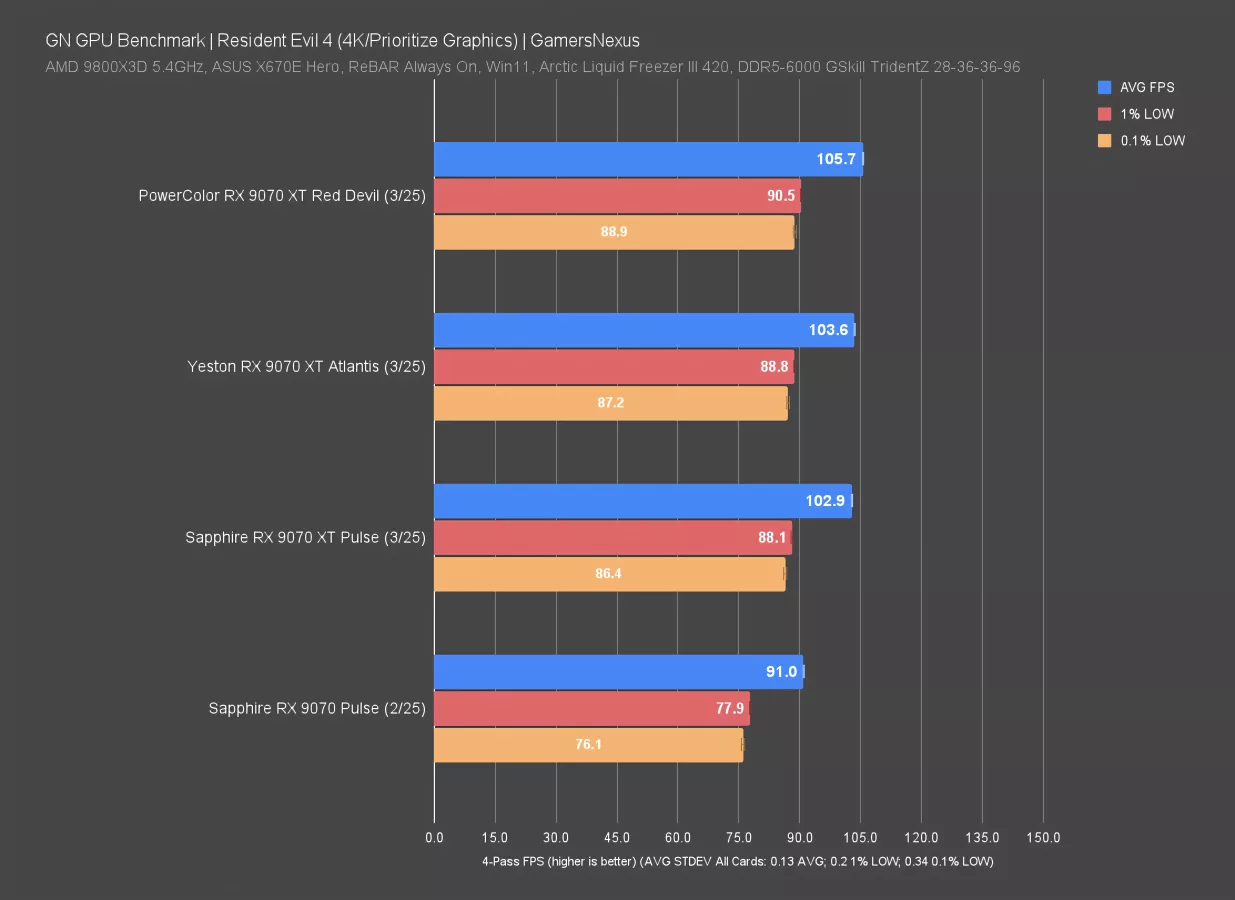
The only thing worse than zombies at 1440p is zombies at 4K, so that’s what we’re rendering now. In Resident Evil 4 at 4K, the Red Devil held a 106 FPS AVG, leading the Waifu by about 2 FPS AVG. That’s around 2%.
All of these numbers are expected. We did technically run 4 other games, but they all show the same thing: Typically, we’re in the range of 1-3% improved on the PowerColor card out of the box.
Conclusion

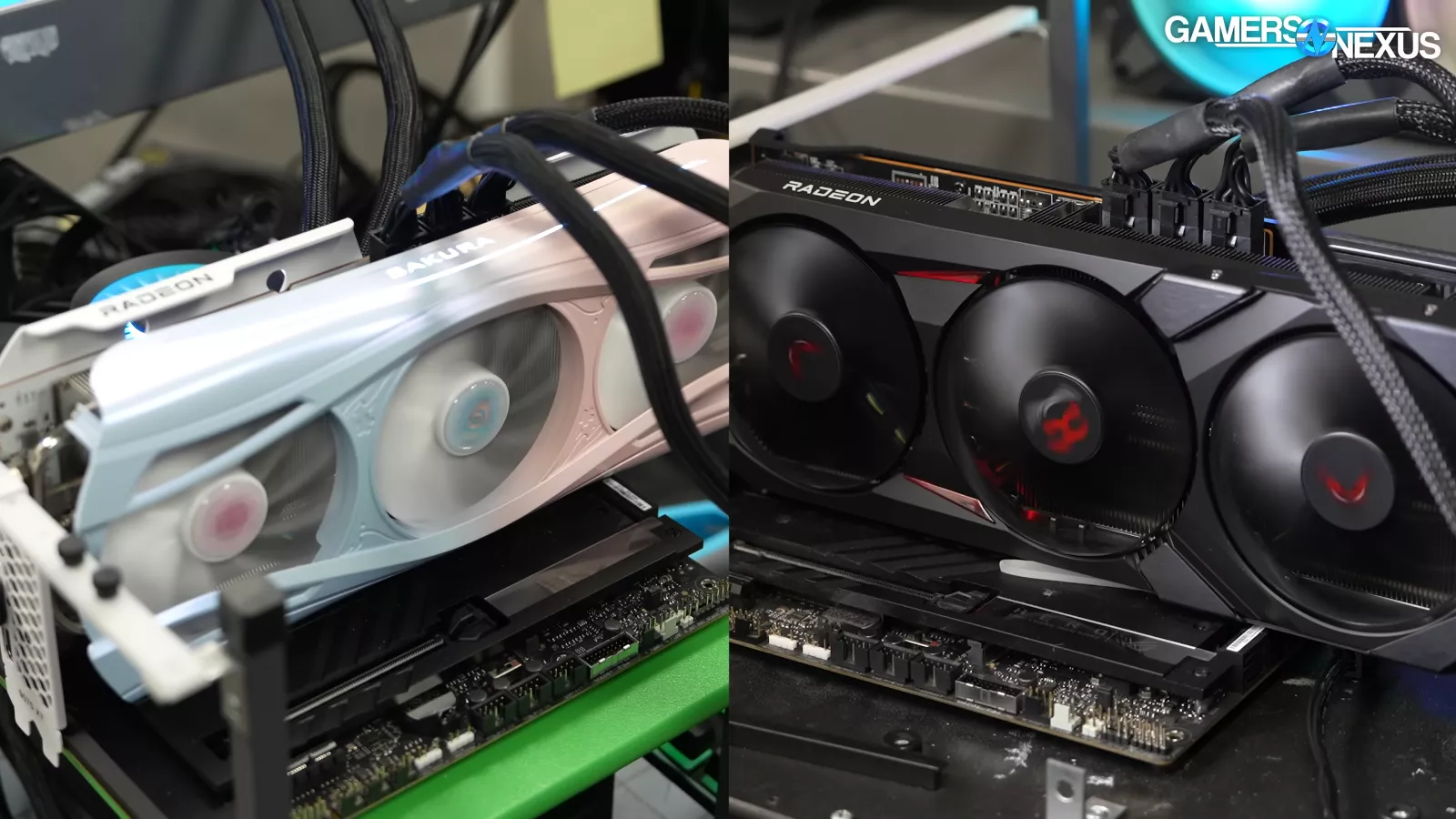
The price for both cards is the same, and they’re both crazy. The good news is that because both are $900, they’re easy to compare.
We have to give both cards credit. Neither are bad. We’ve already reviewed the Yeston RX 9070 XT Sakura Sugar Atlantis OC Edition, in which we also tore down the card. We were fairly positive on it. There were things it could have done better. For example, it doesn’t have as good of a thermal solution as we’ve seen on some of their past cards with this design approach, but it was still fine in pretty much every metric.
For the Red Devil, the biggest place that card is lacking is in underutilizing the ability to tune its fan curves more. This is something PowerColor seems to consistently have problems with in the cards we test from them. The company could utilize it more to better balance the thermals and acoustics more reasonably.
Overall, though, both cards are pretty close to each other. The Red Devil, in noise-normalized situations, tends to be the better cooler, but the Waifu card, out of the box, tends to be the better cooler. It depends on how you’re going to run them. The Red Devil also has a higher clock out of the box and it actually runs faster. Now, in gaming performance, this difference doesn’t really manifest itself in a big way.
We did play around with overclocking on both cards. We got a little higher clocks out of the Red Devil. That card also has a higher power budget.
Both cards are too expensive, however. At least both cards do something to try and justify their price.






![Best Pirate Games 2025 [Ultimate List] Best Pirate Games 2025 [Ultimate List]](https://i2.wp.com/www.gamingscan.com/wp-content/uploads/2022/03/Best-Pirate-Games.jpg?w=1024&resize=1024,1024&ssl=1)









